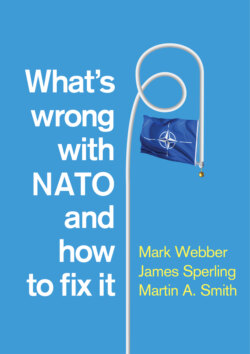Читать книгу What's Wrong with NATO and How to Fix it - Mark Webber - Страница 12
NATO is unique
ОглавлениеIf we accept that NATO is here to stay, an argument still needs to be made as to why this is a good thing. The merits of that argument rest, in large part, on NATO’s own claims to performance: how effectively the Alliance has executed its various missions and, related to this, how convincing have been the reasons for pursuing them. We shall return to these themes throughout the book. Here it is worth putting them in context. Our second assumption is that NATO can undertake operations and, indeed, engage in its full range of activities (military exercises, ballistic missile defence [BMD], nuclear deterrence, partnerships, joint intelligence, surveillance and reconnaissance [JISR], cyber defence, air and maritime patrols, and so on) owing to the development of some unique characteristics.
Ostensibly, NATO is simply a treaty-based alliance of states, a fairly conventional category in international politics. It is, however, much more besides. Since the signing of the North Atlantic Treaty in 1949, the number of NATO allies has grown (from the original twelve to thirty today) and, in parallel, NATO has developed a sophisticated institutional set-up. NATO, consequently, is as much an international organization as it is a military alliance. We will have more to say on this in Chapter 1. The point here is that these ‘institutional assets’, although initially developed during the Cold War, have proven flexible enough to ensure significant NATO adaptation in the three decades since.19 Adaptation has, operationally speaking, not always generated the right results; it has also been painful as NATO has had to learn by doing in the field of operations. Yet adaptation has certainly been dramatic. In the Balkans, Afghanistan and Libya, NATO laid down a series of firsts – in terms of its willingness to work with non-NATO partners, its ability to provide massive and sustained concentrations of force on land, sea and air, and the expansion of its geographical area of operations.20
Alongside these formal structures, NATO has also developed all manner of informal practices of social and political interaction. Allies working in an organization premised on transparency and consensus have thus developed feelings of familiarity and trust in their mutual relations.21 It was noted above that political community, one outgrowth of this dynamic, has been eroded. But an equally important aspect of community remains. NATO is the exemplary case of a ‘pluralistic security community’. Its members hold ‘dependable expectations of peaceful change’ in their relations with one another such that war between them is rendered unthinkable.22 A willingness to desist from violence among one’s peers may be a minimum condition of community, but, given Europe’s history, it is an undeniably important one. The anchoring of Germany within NATO has put paid to any fear among its neighbours of German military revanchism. NATO has also played a role in mitigating the antagonism between Greece and Turkey. The embrace of new members among some former Yugoslav republics is premised on doing something similar in the Balkans.
Both its informal and formal characteristics place NATO at some remove from more transient coalitions of the willing. Modern warfare is rarely conducted by states acting alone. Even powerful states such as the US have come to rely on allies to give added legitimacy to their cause or to widen the pool of assets upon which they can call. Here, a temporary coalition has certain advantages: flexibility of purpose, fluidity of decision-making and ease of dissolution when its purpose has been served. Coalitions, not alliances as such, fought wars against Iraq in 1990/1 and 2003, and since September 2014 a global coalition has battled ISIS in Iraq and Syria. Yet coalitions by their very nature lack the embedded structures and assets of a permanent alliance such as NATO. NATO’s internal politics may mean sluggish decision-making, and capability asymmetries among its members often give rise to burden-sharing disputes. But when NATO acts, it enjoys the benefits of interoperability, unity of command and pooled resources – all of which are an aid to ‘effectiveness [...] robustness and adaptability’.23
